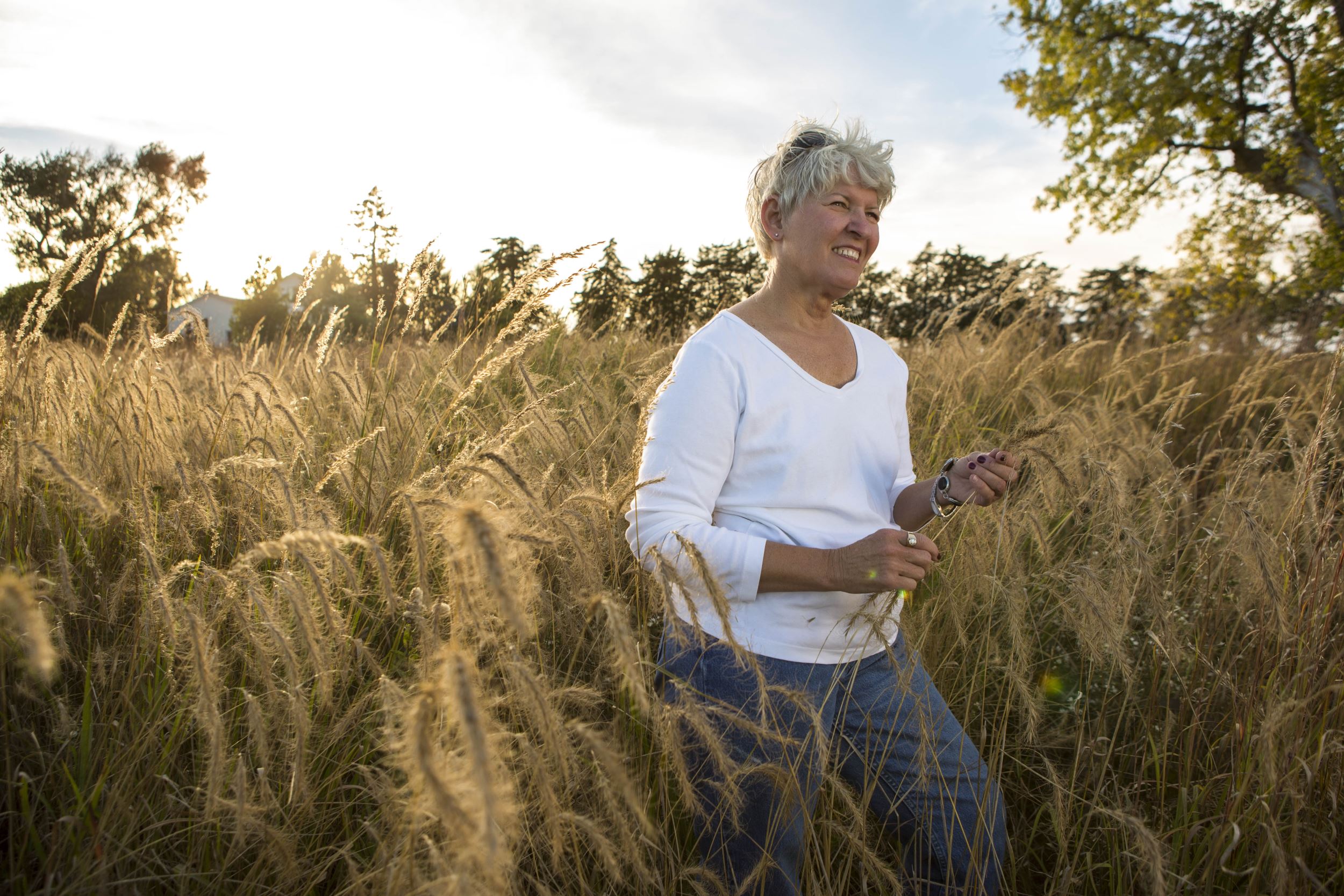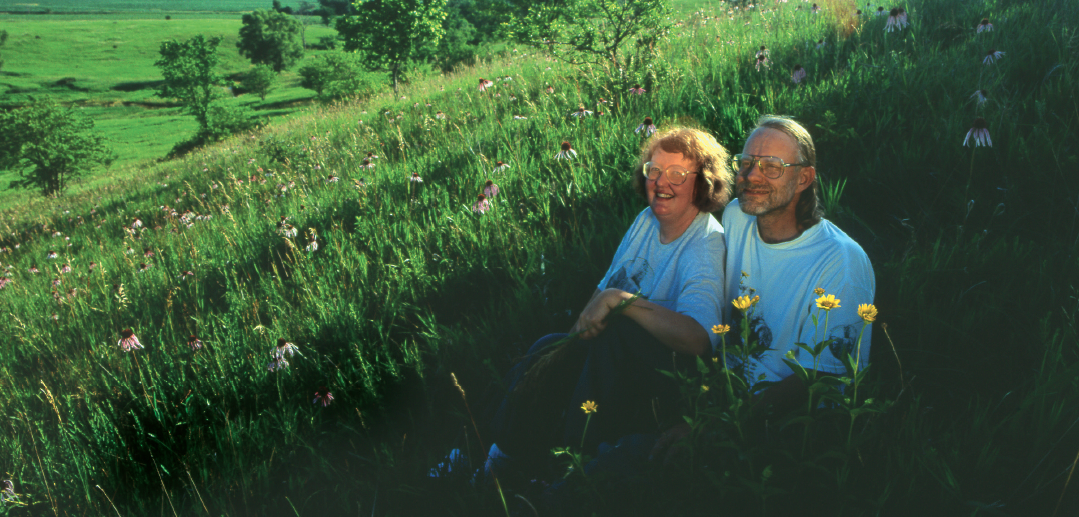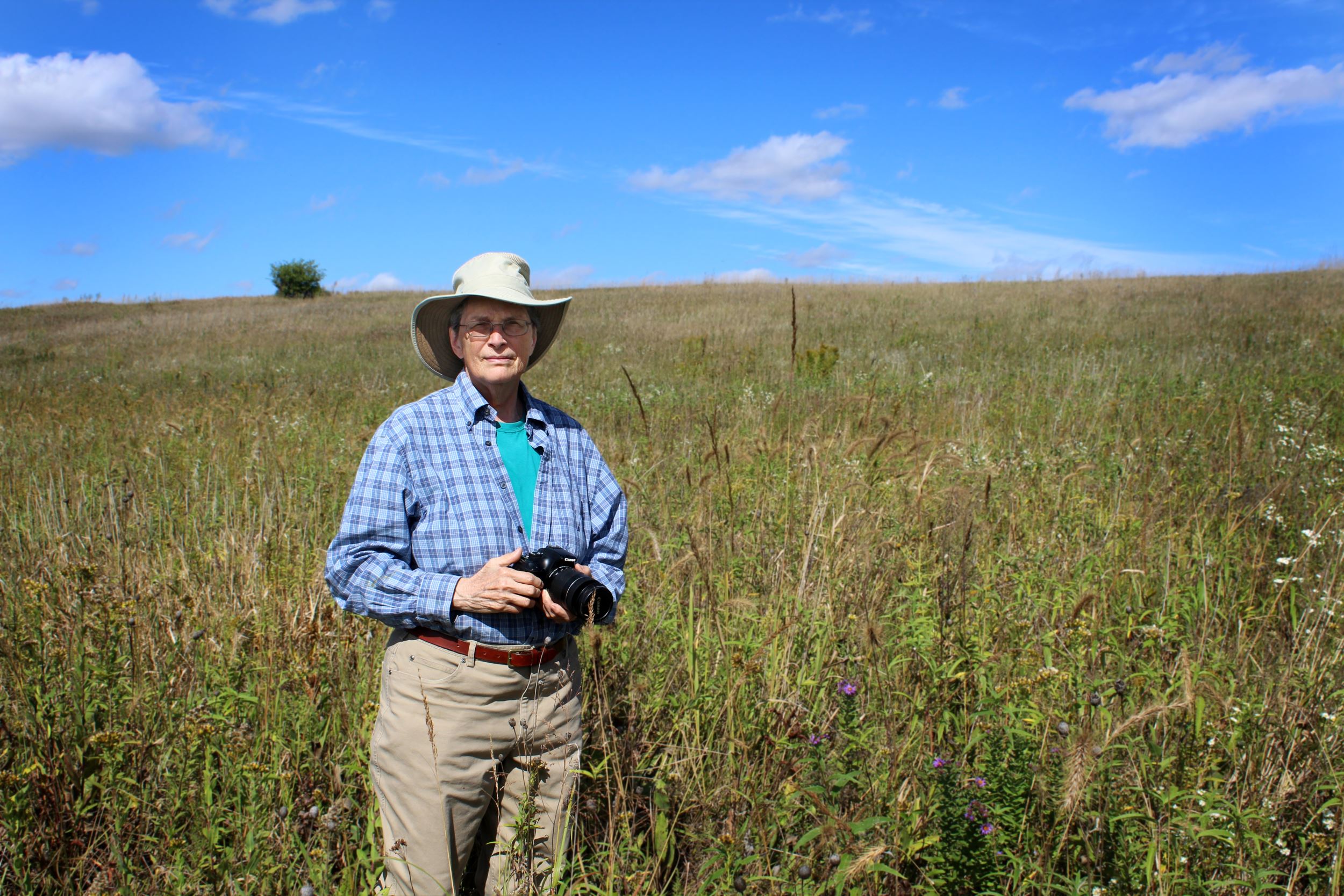A Woman's Place
By Katy Heggen on August 28, 2018 in Blog

Chris Henning, a landowner from Cooper, IA, is just one of many women who has worked with Practical Farmers, an organization re-imagining agriculture in Iowa, and of Iowa and the Women, Food and Agriculture Network, and organization that engages women in building an ecological and just food and agriculture system. Both groups continue to work with more women as significant demographic changes and land transfers take place across the state. Photo courtesy of Practical Farmers of Iowa.
"I want you to be my eyes into the future,” wrote Daisy Whitham, the first landowner to partner with Iowa Natural Heritage Foundation (INHF) to permanently protect her land. Daisy entrusted INHF with Whitham Woods, a 130-acre woodland near Fairfield, knowing it would always be a natural area.
In the nearly four decades since, INHF has worked with landowners across the state to permanently protect Iowa’s wild and working lands. Many of these landowners have been — and continue to be — women. While their stories have always been an essential part of ours, stories of women on the land have been historically underrepresented.
As a growing number of women own, co-own and are making decisions about the future of land in Iowa, increasing attention is being given not only to their stories, but to the stories of the women who came before them, and those forging ahead.
Shaping Iowa’s landscape
Nearly half of farmland in Iowa — 47 percent — is now owned or co-owned by women, per a 2012 Iowa State University report. People over the age of 65 now own over 56 percent of Iowa farmland, and with half of Iowa’s working lands slated to transfer in the coming years, unprecedented shifts are possible.
On the national level, an estimated 70 percent of U.S. farmland will change hands over the next two decades, and it’s projected that 75 percent of that land will go to women. To what extent that projection will hold true for Iowa remains to be seen, but several Iowa organizations have observed an increase in women taking an active interest in owning, managing and working the land.
“We’ve definitely seen shifts in our landowner demographics,” said Sally Worley, executive director of Practical Farmers of Iowa (PFI), an organization that equips farmers to build resilient farms and communities. “We’re going through this huge land transfer right now. With that, we’re seeing more farmland owned by elderly women who are outliving their spouses, and parents that are giving land more equitably to their children.”
The Women, Food and Agriculture Network (WFAN), an organization that engages women in building an ecological and just food and agricultural system, has also noted a growing interest among the younger generation.
“Younger women are coming to our events,” said Carol Schutte, coordinator of WFAN’s Women Caring for the Land program, a program designed to serve women farmland owners who are interested in learning more about conservation. “When we started this program, we assumed we’d have women in their eighties and nineties. They’re coming, but we also have women in their twenties, thirties and forties.”
PFI and WFAN have also seen increased interest in conservation among the landowners they work with, particularly women.
“A lot of women landowners seem to be really interested in adding a conservation component to their farmland,” Worley said. “O
“In my opinion, the biggest trend is not more women who own land, it’s more women who want to work the land or be more involved in making decisions,” said INHF Vice President Anita O’Gara. “We’re hearing from more female landowners who are eager to learn about land, conservation and protection. I sense an increasing boldness about standing up for land so it can be passed forward with pride.”

Cindy Hildebrand and Roger Maddux sit on their restored prairie in Story County. They developed a love of prairie and seed collecting in the '80s, leading to future protection and restoration of Iowa prairies. Photo by Bill Witt.
Urban lots to open prairies
Cindy Hildebrand developed a love for untamed places in an unconventional setting: exploring vacant lots in the Detroit suburbs.
“Free-range childhoods were the norm, and the vacant lots with all sorts of interesting stuff that came up to my waist were much more interesting than the parks with their short, mowed grass,” Hildebrand said.
When Cindy moved to Iowa for grad school, she was eager to explore the prairie.
“I was pretty naïve then,” said Hildebrand. “As I crossed the river into Iowa, I was looking around for the prairie and I saw crops, crops and more crops. It took me a few years to grasp that what I was seeing was where the prairie used to be.”
Eventually, she found her way Doolittle Prairie in Story County.
“I loved the wildness, tall grasses and flowers. There’s something about the prairie being so accessible — it’s right there at waist level. I also felt a certain protectiveness. This landscape had been so huge, and now it exists in tiny fragments. It’s so important to protect the little bits that are left,” she said.
Hildebrand and her husband, Roger, began volunteering at Doolittle Prairie, collecting native seed. It wasn’t long before they decided they wanted a place of their own where they could do prairie reconstruction.
In 1994, Cindy and Roger purchased 72 acres in Story County containing never-plowed prairie remnants. Led by Cindy, the couple has spent the last 25 years creating what INHF President Joe McGovern calls “one of the most admirable prairie restorations around Iowa.” The couple donated a 72-acre conservation easement on the property — now known as Grant Ridge — to INHF in 2005, ensuring the prairie will always be protected.
Cindy and Roger have since donated two other conservation easements on other properties. They intend to gift these and other restored lands to INHF.
“Collectively, it’s been a life-transforming experience,” said Hildebrand. “We don’t have kids. Our land is our legacy.”

Helen Gunderson on her farm in Pocahontas County. Gunderson inherited the land from her grandmother. Her brother managed the land until she came back to Iowa to manage it herself. Helen has since shifted part of her land away from conventional agriculture to practices that serve her values and her bottom line. Photo by Erin Van Waus.
Rethinking Agriculture
Helen Gunderson is not the first woman in her family to have land in her own name. That distinction belongs her grandmother, DeElda Lighter Gunderson, a rare thing in a time when women’s names were missing on most land titles. But Helen is the first to redefine her place on the land, and in that regard, she is a trailblazer in her own right.
“I always had this expectation that the land would be handed down to me and my five siblings and me. That’s not an automatic thing in most families,” Gunderson said.
Still, growing up, she never felt like there was a place for her in farming.
“I felt pretty lost as a child,” Gunderson said. “I didn’t a role for me in farming in the future, and didn’t really want to step into the limited roles that were available to women.”
So she left. When Helen inherited her share of the farm from her grandmother, her brother, who had been groomed to farm from a young age, managed her land in her absence.
In adulthood, Helen became passionate about local foods, sustainable agriculture and community, and as a result, frustrated with the way her land was being farmed. When a her spiritual mentor asked when she was going to start managing her own land, she balked.
“I said, “Oh, I can’t do that, that's not how things are in done in our family where it is expected that men will make the decisions.'"
But the more she thought about it, the more Helen realized not only was she qualified, she was compelled. That was nearly 25 years ago. Helen’s been managing the land ever since.
She’s shifted part of her land away from conventional agriculture to practices that serve her values and her bottom line. She rents land to a family friend Betsy Dahl, who shares her commitment to sustainable agriculture. Helen and Betsy harvested their first organic-certified crop last fall — an achievement Helen is especially proud of. Helen grows an assortment of organic fruits and vegetables at her home in Ames, raises chickens and regularly invites students, neighbors and curious passersby to come learn about what she’s doing.
In 2011, Helen donated 60 acres of pasture, CRP and cropland to INHF. It’s now known as DeElda Heritage Area. Five years later, she donated the adjoining 180 acres to INHF with a reserved life estate, giving her lifetime use and income.
In redefining the land, Helen has also redefined herself and her place in the culture of agriculture.
“I’m glad for the journey and happy with where I’m at, but I’m always looking ahead and asking myself what more can I do,” Gunderson said. “It’s a continuum.”
Sowing the future
Cindy, Helen and other women like them have reshaped the landscape, and in doing so, the stories of women on the land. They’re part of a growing group of women in agriculture and conservation being recognized for their leadership.
“There have always been women on the land,” said O’Gara. “Over the years, we’ve had the opportunity to work with many women who have been leaders in land protection. This is not new. This is merely a continuation of an existing trend.”